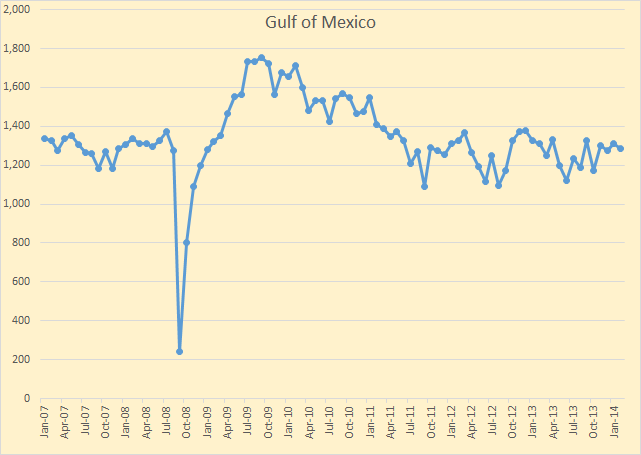I found that looking at the crude oil production of every country plotted on an annual basis gave one a different perspective.
All charts below are through 2013 and in thousand barrels per day.
I found that looking at the crude oil production of every country plotted on an annual basis gave one a different perspective.
All charts below are through 2013 and in thousand barrels per day.
Not much new data to report this past week but I did try to hammer out a few things of interest. The EIA released their Crude Oil Production report for the US and individual states with data through February 2014. I combined Montana and North Dakota to show their production.
 Their combined production was 1,027 kb/d. This is still below their production of 1,055 kb/d in November. This is more than just the Bakken as both Montana and North Dakota have production outside the Bakken.
Their combined production was 1,027 kb/d. This is still below their production of 1,055 kb/d in November. This is more than just the Bakken as both Montana and North Dakota have production outside the Bakken.
 Part of the EIA’s plan for 9.6 mb/d of C+C by 2016 has The Gulf of Mexico going to 2 million bp/d by 2016. The GOM does not appear go be going anywhere however. There are new fields coming on line but they are just barely keeping up with those very high decline rates of the deep water fields. The Gulf of Mexico has her very own Red Queen.
Part of the EIA’s plan for 9.6 mb/d of C+C by 2016 has The Gulf of Mexico going to 2 million bp/d by 2016. The GOM does not appear go be going anywhere however. There are new fields coming on line but they are just barely keeping up with those very high decline rates of the deep water fields. The Gulf of Mexico has her very own Red Queen.
Read More

Figure 1
This was also posted at Peak Oil Climate and Sustainability
It has been a while since I have updated my estimate of actual output from the Eagle Ford.
Kevin Carter (KC at Peak Oil Barrel) graciously offered help pulling together data for the 39 fields which make up the Eagle Ford play (see this page at the RRC of TX, spreadsheet download here .)
Kevin has strong programming skills in Visual Basic for Applications (VBA) and has made the job of gathering the Eagle Ford data considerably easier. Thank you Kevin!
My previous estimates only included the Eagleville fields (Eagle Ford 1 and Eagle Ford 2 and the inactive Eagle Ford and Eagle Ford Sour fields), Briscoe Ranch, Sugarkane, Dewitt, Gates Ranch, Hawkville, and Eagle Ridge fields. Together these 10 fields produce about 99% of Eagle Ford C+C output so these previous estimates are not bad, this new estimate includes all Eagle Ford output reported by the RRC from June 1993 to January 2014.
Note that from June 1993 to Dec 2006 C+C monthly output from the Eagle Ford play was 12 b/d or less, which is why the chart starts at Jan 2007.
An Excel spreadsheet with the data can be downloaded here . More below the fold.
The EIA just published their latest Drilling Productivity Report. They kept their very linear increase for all LTO plays except for the Bakken. Strangely they updated their Bakken data right up through January according to the data they apparently received from North Dakota.
The last data point is February for the North Dakota data and May for the DPR data.
But the EIA posted some strange Legacy Decline numbers for the Bakken;
Now this just doesn’t make any sense. The legacy decline is supposed to be the number of barrels per day all the wells in the combined declined. That number should increase, but gradually as new production comes on line. That is the more production the greater the decline. They have the decline rate at 60,553 bp/d in November, jumping to 123,248 in December, then falling back to 63,459 in January. That is impossible! The decline, in barrels per day, increases as production increases. But if production decreases then the number of barrels per day that declines must decrease, not increase.
The latest Update on Bakken and North Dakota LTO production is out.
ND Monthly Bakken Oil Production Statistics (Bakken Only)
ND Monthly Oil Production Statistics (All North Dakota)
Bakken production in February was 888,398 barrels per day and all North Dakota February production was 951,350 barrels per day. Some revisions were made in the past production numbers. Only the last three months were significant however. Listed below are the actual production changes, per month, for the last three months:
Month Bakken North Dakota
Dec 13 -45,528 -40,284
Jan 14 6,542 -2,218
Feb 14 16,643 16,224
The Director’s Cut for this has not been published yet. I will update this post when it has been. There were 119 additional wells in the Bakken and 79 in all North Dakota. That means a lot of North Dakota Wells were shut down.
A Bismark engineering firm has calculated the probable Bakken Peak.
Competition from Texas, winter expected to limit ND oil production
MINOT, N.D. – North Dakota oil production, which is poised to break the 1 million barrels per day benchmark, will peak at 1.2 million to 1.5 million barrels per day over the next five years, limited by winter weather and competition from Texas, a Bismarck engineering firm said this week.
I have charted that prediction below. The figures are the average yearly production.